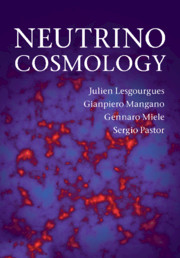Book contents
- Frontmatter
- Contents
- Preface
- 1 The basics of neutrino physics
- 2 Overview of the Standard Cosmological Model
- 3 Neutrinos in the early ages
- 4 Neutrinos in the MeV age
- 5 Neutrinos in the cosmic microwave background epoch
- 6 Recent times: neutrinos and structure formation
- 7 Cosmological neutrinos today
- References
- Index
Preface
Published online by Cambridge University Press: 05 March 2013
- Frontmatter
- Contents
- Preface
- 1 The basics of neutrino physics
- 2 Overview of the Standard Cosmological Model
- 3 Neutrinos in the early ages
- 4 Neutrinos in the MeV age
- 5 Neutrinos in the cosmic microwave background epoch
- 6 Recent times: neutrinos and structure formation
- 7 Cosmological neutrinos today
- References
- Index
Summary
To Arianna, Carmen, Isabelle, and María José
When neutrinos first came on the scene in 1930, their father, Wolfgang Pauli, confessed to his colleague, the astronomer Walter Baade, that to save energy conservation in β-decays (quoted in Hoyle, 1967),
I have done a terrible thing today, something which no theoretical physicist should ever do. I have suggested something that can never be verified experimentally.
This was perhaps the only time Pauli was mistaken. Less than 30 years later, neutrinos were discovered by Reines and Cowan.
Since then, we have learned so many things about neutrinos that Pauli himself would be very surprised. More than this, understanding neutrino properties has always brought new insights into the whole field of fundamental interactions, and new theoretical paradigms.
Today we know quite accurately how to describe their feeble interactions with matter, from the very first attempts of Fermi to the succesful Standard Model of electroweak interactions. Many pieces of information have been collected in laboratory experiments, the traditional setting of particle physics. The study of neutrino interactions has been pursued at accelerators and reactors and, more recently, by sending neutrino beams produced at accelerators to underground laboratories. Accelerator experiments have also confirmed that there are only three generations of light neutrinos which are weakly interacting.
- Type
- Chapter
- Information
- Neutrino Cosmology , pp. ix - xiiPublisher: Cambridge University PressPrint publication year: 2013



